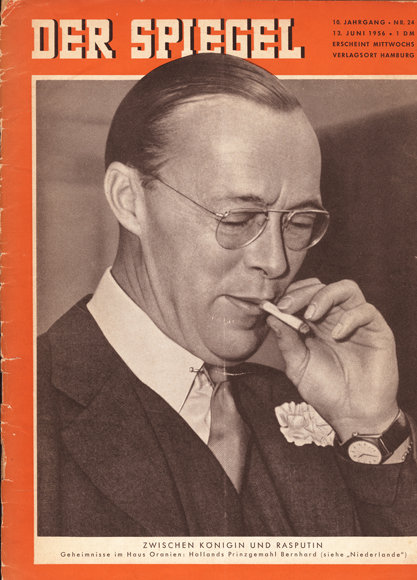1945-2000: Mass Media and Censorship II

Der Spiegel of 13 June
1956
The Greet Hofmans affair, 1956
In June 1956 the tribulations at Soestdijk Palace (the royal residence), which had been kept secret for years, finally became public. The spark in the powder keg was an article in the Hamburg-based magazine Der Spiegel of 13 June 1956 about the supposed influence of the faith healer Greet Hofmans on Queen Juliana. The assumed source was Prince Bernhard, who for years had been trying to banish Hofmans from Soestdijk and Juliana's life. There were rumours that Juliana was being forced to abdicate, possibly on grounds of mental incapacity, in favour of Crown Princess Beatrix. The crisis was weathered and Juliana remained on the throne. She was however forced to dismiss Hofmans and several members of her household, including her private secretary Walraven van Heeckeren van Molecaten.
The Hofmans affair was a prime example of self-imposed censorship by the Dutch press. As early as 1954 a gathering of editors-in-chief had decided to maintain radio silence on the issue of Hofmans and the troubles at Soestdijk. When the bombshell burst in mid-1956, the editors-in-chief promised Prime Minister Drees that they would reveal nothing of the matter. But the foreign press published the news.
The correspondents Henk Kersting and Nel Slis of the Associated Press (AP) sent constant reports to the AP offices. H.A. (Henk) Lunshof devoted several articles in Elseviers Weekblad to the case. On the evening of 11 October 1956 he conducted a confidential interview with Van Heeckeren van Molecaten at the latter's home. Van Heeckeren already knew that he would have to resign. According to Juliana's secretary, who was also a Hofmans adept, Bernhard and Beatrix were involved in the plot to get Juliana to abdicate. As far as can be established this interview was never used by Lunshof in his articles.
In June 1956 the tribulations at Soestdijk Palace (the royal residence), which had been kept secret for years, finally became public. The spark in the powder keg was an article in the Hamburg-based magazine Der Spiegel of 13 June 1956 about the supposed influence of the faith healer Greet Hofmans on Queen Juliana. The assumed source was Prince Bernhard, who for years had been trying to banish Hofmans from Soestdijk and Juliana's life. There were rumours that Juliana was being forced to abdicate, possibly on grounds of mental incapacity, in favour of Crown Princess Beatrix. The crisis was weathered and Juliana remained on the throne. She was however forced to dismiss Hofmans and several members of her household, including her private secretary Walraven van Heeckeren van Molecaten.
The Hofmans affair was a prime example of self-imposed censorship by the Dutch press. As early as 1954 a gathering of editors-in-chief had decided to maintain radio silence on the issue of Hofmans and the troubles at Soestdijk. When the bombshell burst in mid-1956, the editors-in-chief promised Prime Minister Drees that they would reveal nothing of the matter. But the foreign press published the news.
The correspondents Henk Kersting and Nel Slis of the Associated Press (AP) sent constant reports to the AP offices. H.A. (Henk) Lunshof devoted several articles in Elseviers Weekblad to the case. On the evening of 11 October 1956 he conducted a confidential interview with Van Heeckeren van Molecaten at the latter's home. Van Heeckeren already knew that he would have to resign. According to Juliana's secretary, who was also a Hofmans adept, Bernhard and Beatrix were involved in the plot to get Juliana to abdicate. As far as can be established this interview was never used by Lunshof in his articles.
Call number: PM
Kleine Collecties, Greet Hofmans-affaire


